Monday, January 9, 2017
100% buck wheat soba 十割蕎麦
Since it was rather cold outsdie, we decided to have it warm.
It does not show well but I added mitsu-ba ミツバ as garnish.
The picture below was before pouring in the soup. I diluted the accompanied sauce with my dashi broth (from kelp and bonito flakes I made few days ago).
As a topping, I used red and white fish cake 紅白蒲鉾 in a decorative cut. I also added New Year's omelet roll or Datemaki 伊達巻 that I made. I garnished it with chopped scallion and mitsuba.
The 100% buckwheat flour noodles had a unique texture unlike standard soba noodles. It was nicely firm, slightly brittle with a lovely fresh soba smell. We also detected a slight nutty flavor. We really enjoyed this distinctive artisan soba very much.
Wednesday, December 14, 2016
Cod with tofu soba noodle 鱈ちり風かけ蕎麦
Thursday, September 15, 2016
Cold pasta with smoked salmon and tomato トマトと燻製サーモンの冷製パスタ
Friday, August 19, 2016
Cold pasta with cilantro Jalapena sauce 冷製パスタのハロペニョソース
I added leftover slices of barbecued and hot smoked pork loin, spicy baked tofu, simmered cold vegetables (I only used carrot for color), julienne of cucumber.
Tuesday, December 15, 2015
Meatball Udon Pasta ミートボール入りうどんパスタ

I also quickly made the sauce from leftovers. I had some tomato sauce which I made a few days before for pizza. I just added cream to the sauce to change the flavor profile and consistency. The Japanese udon noodles were also cooked a few days ago.

I garnished it with chopped parsley and grated parmigiano-reggiano.
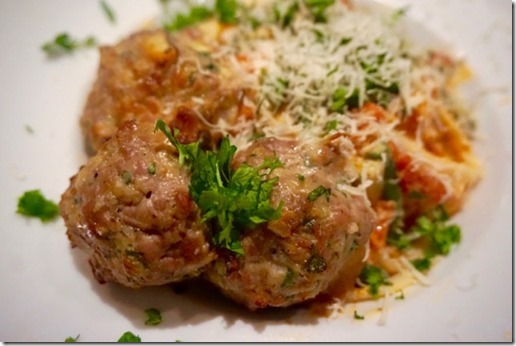
Meat balls:
1 lb ground pork: I hand chopped the trimmings of two pork tenderloins.
1 large shallot finely chopped
3 medium fresh shiitake mushrooms, stem removed and chopped
1 tsp olive oil
1/2 cup or more panko bread crumbs
2-3 eggs, the amount of panko and eggs depending on the consistency of the mixture
I sautéed the shallot, shiitake mushrooms in a frying pan with olive oil for several minutes, seasoned with salt and pepper. After it cooled down to room temeprature, I mixed it into the ground pork and added dried oregano, basil, salt, pepper, panko, and eggs and mixed well by hand. I like the mixture to be rather soft, I adjusted the amount of panko and eggs to get the right consistency.
Using a medium sized, ice cream scoop, I placed a scoop full of the mixture on an oiled baking sheet. I added a small amount of olive oil and shaped it into balls. I put them in a preheated 350F oven for 20-30 minutes. I like the meat balls that are rather eggy. When done, they are not perfectly shaped spheres; the bottoms are flat and the tops rounded but somewhat irregular. Nonetheless I prefer this "artisanal" shape to dry dense perfectly shaped meat balls.
Tomato sauce:
2 large cloves of garlic, finely minced
1/2 medium onion, finely diced
3 tbs olive oil
2 14oz can of whole tomato, crushed by hand
dried oregano, basil, hot red pepper flakes, salt and black pepper to taste
I first sautéed the onion and garlic on low heat for a few minutes and added the tomato which was crushed by hand and excess liquid drained. When it started simmering, I added the seasoning and simmered for at least 30 minutes or longer depending on how much liquid I started with. When I have time, I add more liquid from the canned tomato and cook longer. If too acidic, I add a bit of sugar to the sauce.
Noodles: I just used dried "Sanuki" udon and cooked it boiling water for about 13 minutes as per package instruction.
In a frying pan on medium low flame, I added the tomato sauce and meat balls. When they were warmed up, I added cream and mixed. The amount of cream is to your liking. I then added the udon noodles until the sauce clung to the noodles and warmed up. I served the noodles with three meat balls per serving and topped it with a bit of fruity olive oil, parmigiano-reggiano, and chopped parsley. My wife sprinkled a bit more salt on hers. Since, everything was prepared ahead, putting together this dish was easy and quick. By adding cream, acidity of the tomato sauce was further reduced. It was very satisfying comfort meal.
Thursday, December 3, 2015
Ramen #4 Miso Ramen 味噌ラーメン

The toppings can be anything but I made something different. I even added a pat of butter which was not done when I lived in Sapporo but is now added with some corn mostly so tourists can have the "Hokkaido" food experience. Again, I made half-ramen (one serving divided into two servings) or han-ramen 半ラーメン.
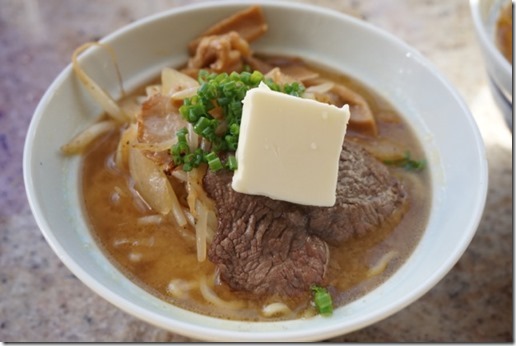
Since I had pork belly and also a small slice of filet mignon, I decided to use these as toppings as well.
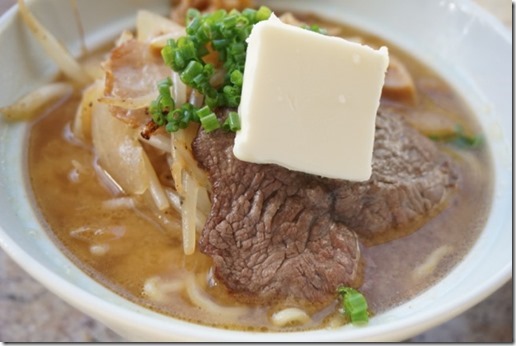
On the left below is the sliced filet pounded until thin and pork belly thinly sliced.

Topping:
Onion: one medium onion cut in half and then sliced into thin strips.
Bean sprouts: One package of mung bean sprouts washed and drained.
Filet mignon: thinly sliced and then pounded thin. Seasoned with salt and pepper.
Broth: In a separate pan, I boiled water (about two cups) and dissolved one package of the miso flavoring that came in the package. I used more water than specified but it tasted salty enough.
I cut the pork belly in small bite sized pieces. I sautéed it in a frying pan with a small amount of peanut oil and a dash of roasted sesame oil. When the meat was cooked, I added onion and sautéed it until soft and edges were slightly brown. I then added the bean sprouts and kept sautéing for a few more minutes. I seasoned with salt and pepper and a bit of miso flavoring from the packet.

I kept the miso flavored broth on simmer and boiled the noodles in a separate pot. After I tasted for doneness of the noodle, I drained and shook off the additional moisture using a strainer. I placed the noodles in two bowls, poured on the broth and topped with the onion-sprout mixture. I quickly cooked the steak in a separate frying pan with butter (30 seconds on each side).
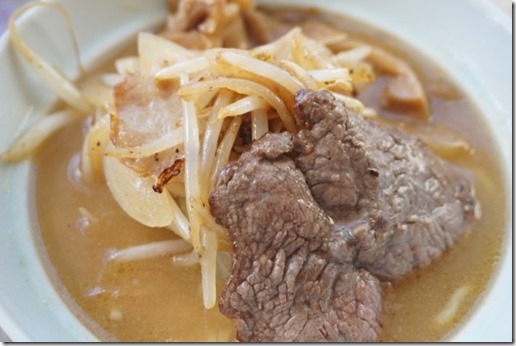
I also added menma メンマ or seasoned bamboo shoots.

I garnished it with chopped chives and a thin pat of butter (second and third pictures above).
The noodles were different from the noodles in the shouyu ramen (which was Tokyo straight noodle). They were curly with a firm yet elastic texture (this must be the company’s version of the "Sapporo noodle"). The soup was quite good with the taste of pork/chicken-based broth.The butter added a nice richness but being a traditionalist probably was not needed.
Thursday, November 12, 2015
US-made Ramen noodle #3 ラーメン その3 アメリカ製
This time, my excuse for posting another ramen is that recently at my Japanese grocery store I found frozen ramen noodles which are made in US . This company called Sun Noodle appears to have originated in Hiro, Hawaii by a Japanese American who was born there. They have facilities in other locations including Los Angeles and New Jersey. They also run a pop up ramen restaurant in New York and give ramen classes. Besides specialty retail stores, they provide ramen noodles to restaurants and appear to be very dedicated to introducing authentic ramen noodles to Americans. I was curious about how good these noodles would taste. This particularly package came with seasoning packets. I chose a classic "shoyu" or soy sauce flavor.
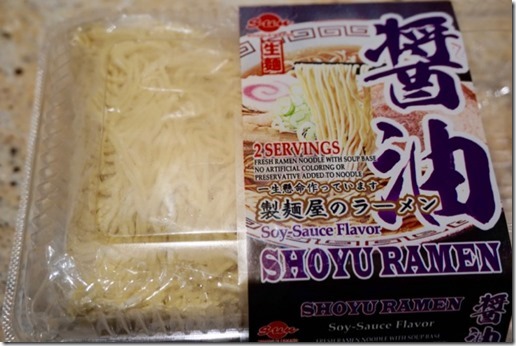
I divided up one serving of the noodles into two and made two half ramens or "han-ramen" 半ラーメン.

I made sort of classic ramen toppings with roasted pork チャーシュー, seasoned bamboo shoot or menma めんま, seasoned soft boiled egg or "ajitsuke tamago" 味付け玉子, nori and chopped scallion.

Of course, I used pasteurized eggs for this.
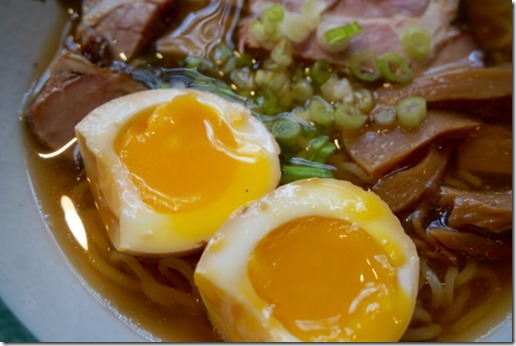
Some years ago, we bought sporks, a hybrid fork and soup spoon designed specifically to eat ramen in chain noodle restaurants called "Sugakiya", from the museum store of MOMA . I got the sporks out since I remembered that we had them. This spork is very awkward to use and we switched to chop sticks. Good idea but not really practical.

Toppings:
Pork: This was re-purposed left-over barbecued pork. The weekend before we barbecued pork loin on our Weber grill. It was hot smoked and seasoned with salt, black pepper and fresh rosemary. Since I had a one inch thick end piece left, I decided to make it into a ramen topping. I had left over clear soup which was based on broth made from a "Dashi pack" with dried bonito and kelp. I reused this soup by adding more mirin, soy sauce, and sake. I also added one star anise and slices of ginger. I made this simmering sauce rather strong. I then simmered the barbecued pork in it for 30 minutes. I let it cool down to room temperature and placed it in the refrigerator. Just before serving, I sliced it to make 4 good sized portions (2 per person).
Seasoned eggs: I made two soft boiled eggs (7 minutes in simmering water) using pasteurized shell eggs. I peeled the shell and placed the shelled egg in the simmering sauce I used for the pork (above). I placed it in the refrigerator and marinated overnight.
Seasoned bamboo shoot: I just used a commercial product that came in a jar which I bought at the Japanese grocery store when I got the ramen noodles.
Ramen Broth: I made broth from a dashi pack which contained dried fish (bonito, sardine, kelp). I made it rather strong. I had a choice of adding the pork simmering sauce I made or the seasoning packet that came with the noodles. Since this exercise was to see how good these US made ramen were, I added the seasoning packet to the broth. I did not add the entire package at once but in increments as I tasted it. I used about 70%. This made a rather classic shoyu ramen broth. With my strong fish based broth, it had a clean classic taste.
Ramen noodles: I followed the instruction on the package. After I thawed the noodles, I boiled the them but rather than timing it, I checked the doneness as I cooked the noodle. Some ramen fans really like "hard" or undercooked ramen noodle but we like an properly cooked (just a bit al dente) noodle. I then drained the noodles and placed them in the ramen broth.
We were quite impressed with the quality of these US made ramen noodles. The noodle was straight (not curly) and had a nice toothyness. I assume they were in the style of "Tokyo straight noodles". The company makes 6 different ramen noodles. The slices of pork were also unexpectedly good despite my impromptu repurposing especially since the slices had more fat than the rest of the loin. The best was the egg. The egg yolk was still runny and the white absorbed the nice flavor of the pork simmering sauce. We were quite satisfied with this ramen.
Monday, September 7, 2015
Chicken aspic terrine 鶏肉のジェルテリーヌ
The image below is the "remake" of my first attempt. I missed one sentence in the recipe "Terrine will be quite fragile: If slicing, use an electric knife; otherwise, serve with a spoon". The first terrine (see picture below, the second from the bottom) was so fragile and I could not slice it using a regular (very sharp I might add) knife.
After the remake, I could slice it and present it on the plate. I served it with fresh cilantro and the sauce (hoisin and rice vinegar) (below).
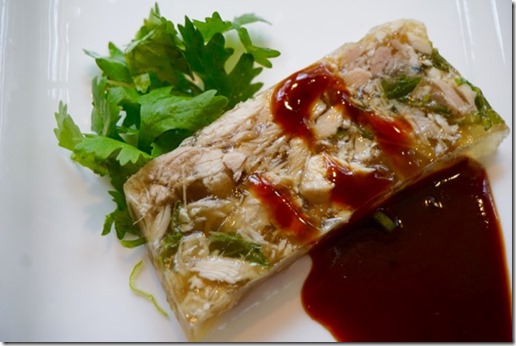
I served this with soba noodles which was suggested in the original recipe. I did not think the hoisin sauce would be suitable for soba so I served the usual dipping sauce with the addition of nori and scallion.
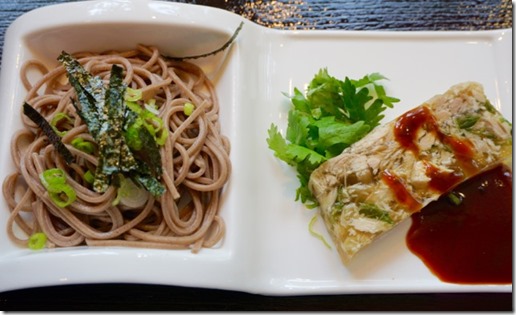
Come to think of it, we have not eaten soba for some time. But in hot summer this is a good especially in combination with the chilled and jellied chicken terrine.

This was a cold plate lunch on another day. I served this terrine with my potato salad, grilled corn and black bean salad, bulgur wheat salad and Montparnasse cauliflower.

I made some modifications the the original recipe especially since the chicken meat I used was already cooked.
3 cups chicken broth, fat skimmed (I used low fat low salt Swanson chicken broth).
1/2 cup medium-dry Sherry (I used half and half of sake and mirin, instead)
2 teaspoons soy sauce (I used light colored soy sauce to keep jell light in color)
1 1/2-inch piece fresh ginger root, cut into 1/4-inch-thick slices
6 scallions, each cut crosswise into thirds and flattened with the flat side of a large knife
1 1/2 tablespoons star anise pieces, crushed lightly
1/2 teaspoon salt
1 pound skinless boneless chicken breasts*(about 3 breast halves) (I used both white and dark meat from barbecued chicken, hand shredded about 2 cups).
1 envelope plus 1 1/2 teaspoons (about 4 1/2 teaspoons total) unflavored gelatin (I added one more package when I remade the terrine).
1/2 cup fresh cilantro leaves, washed well and spun dry
*If using uncooked chicken, porch in the broth for 15 minutes and after removing the chicken, add water to make the amount of the liquid to 3 cups.
For sauce
2 tablespoons hoisin sauce
4 teaspoons rice vinegar (not seasoned)

Meanwhile, I sprinkled the gelatin powder in 1/4 cup of water and let it bloom. I put the broth back in the same pan on simmer and whisked in the bloomed gelatin. when the gelatin melted completely, I cut the flame and poured the mixture over the chicken meat and cilantro. After the mixture came to room temperature, I moved it to the fridge and let it cool over night. I un-molded the terrine (by soaking the bottom of the pan in hot tap water for a few seconds). It looked nice as seen below. But it was too fragile to slice. We ended up tasting (as the original recipe suggested) using a spoon. It was remarkably good. The star anise and cilantro and soy sauce all went together.
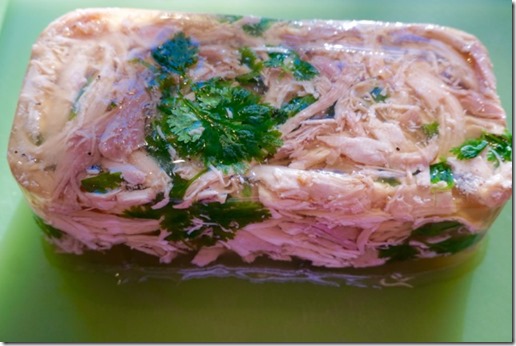
The next day, I remade this terrine. I placed the jelled terrine in a pan and warmed it until the gelatin melted. I then removed the chicken meat with a tong and placed it in the loaf pan. I bloomed an additional package of unflavored gelatin in 1/4 cup of cold water. I whisked in the bloomed gelatin and after it melt completely, I poured it over the chicken meat. This time, all the chicken pieces were coated with gelatin-broth mixture and the additional gelatin made the terrine firmer. After over night refrigeration, the terrine was formed (below).
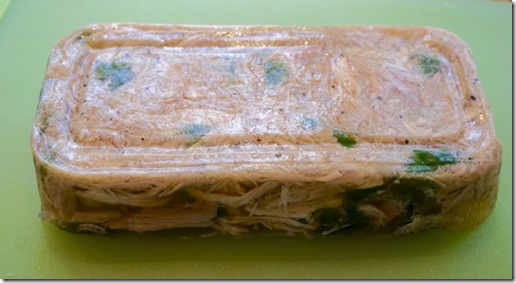
This time, the terrine was firm enough and the all chicken pieces were coated with the gelatin-broth. I could slice it nicely without tearing the entire thing apart. The hoisin sauce and rice vinegar combination made a nice sauce which complimented the flavor of the jellied chicken terrine very well. The addition of fresh cilantro added fresh flavor. This is rather delicate "Asian" flavored chicken terrine.
Thursday, February 5, 2015
“Fearsome” sanuki-udon noodle 恐るべきさぬきうどん
I made this warm udon in broth or Kakeudon かけうどん with a slice of barbecued pork, abura-age deep fried tofu and shimeji mushroom.
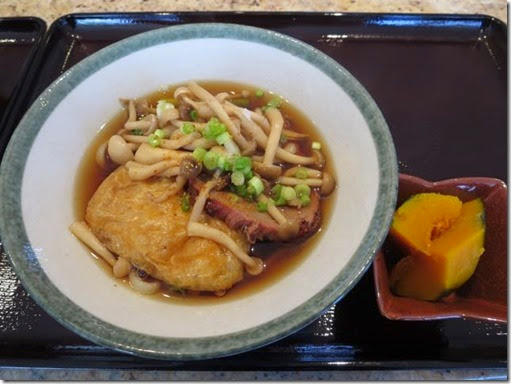
I also served my simmered "Kabocha" pumpkin.
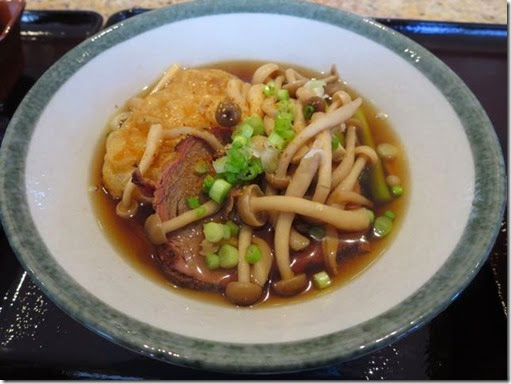
The picture below shows a package of "Fearsome" sanuki udon 恐るべきさぬきうどん.
The noodles are semi-dried and much longer (folded in half) and slightly thicker than the usual dried varieties. It takes a bit longer to cook as well. I cooked it as per the package instructions, washed it in cold running water and placed it in a broth on simmer. The noodle has a bit more bite or firmness in the center than regular noodles. It is good but we are not sure if it is worthwhile to specifically buy this kind.
I used the noodles another time to make "Nabeyaki" udon 鍋焼きうどん. Since I had mochi 餅 left over from New Year, I also added mochi in a fried tofu pouch as well as simmered vegetables (daikon 大根, carrott, kon-nyaku コンニャク、all pre-cooked in a seasoned broth). I also added an egg and scallions.

Just before serving, I removed the tooth pick and cut the mochi in the pouch.

In this dish, I cooked the noodles with the other precooked items and the egg for 5 minutes. The noodles stayed rather firm in the center. These semi-dried udon noodles are good but since we are not dedicated connoisseurs of udon, the differences between this and the usual kind is not great enough to seek out this particular kind.
Digression alert: I later learned that "Osorubeki sanuki udon" 恐るべきさぬきうどん is the name of a column that appeared in a local magazine in Kagawa. The entire series of columns were published as multiple books by Kazutoshi Tao (田尾和俊). These book are a detailed guide of large and small udon noodle places in Kagawa which was said to have popularized udon tourism and restaurant tours. This particular noodle producer must be one of these udon places and must have somehow gotten the right to use this name.
Monday, January 12, 2015
Sushi Taro's New Year's eve soba noodle 寿司太郎の年越しそば
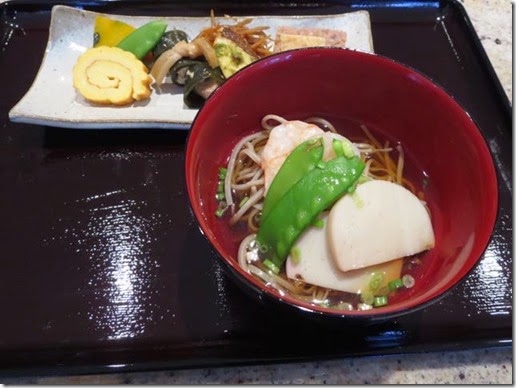
I also served some items from the box as well as ones I made. A piece of fish (the second from the right) is from the box, grilled Japanese snapper with sansho miso paste 真鯛の木の芽焼き which I heated up in the toaster oven which made it much better than when it was cold. This time, new year’s omelet roll or “date maki” 伊達巻き was from the box, although I also made my own. The rest are from what I made for the new year.

Even though this was lunch this type of food, calls for sake and it is very difficult to resist. We succumbed but restrained ourselves to only one small sake glass full.
Friday, February 14, 2014
New Year's eve soba noodle from Sushi Taro Osechi 寿司太郎の年越しそば

There appears to be many variations of toshikoshi soba (cold or hot in a broth etc), I made it to "zarusoba" ざるそば as you see above. ("Zaru" means "bamboo basket" as the noodles are served a special flat bamboo basket or in a special container like I used).
The Sushitaro soba came in a separate box with instructions. According to Chef Kitayama's description, it was made from specific soba and wheat flours produced in Hokkaido. A pieces of kelp and "Katsuobush" 鰹節 dried bonito flakes (real "MaCoy", probably shaving from the ends of the dried bonito or katsuobushi were included and were perfect to make dashi). I followed the instructions and prepared the soba and dipping sauce. For garnish, I served thinly sliced scallion and nori strips. I also added Japanese red pepper flakes ("Ichimi tougarashi" 一味唐辛子)

The noodles had a nice al-dente texture and we enjoyed it although it was not the "end-of-the-year" but "beginning-of-the-year" soba.
Saturday, April 27, 2013
Botargga pasta variation 唐墨パスタその2

I just sauteed the cooked angel hair past in olive oil to warm it up with small amount of red pepper flakes. After the pasta was coated with oil and warmed up, I added a few tablespoons of cream and let it cook for one minute or two so that it made nice sauce that could cling to the pasta. I cut the heat and mixed in grated botargga and garnished with thinly sliced botargga and nori strips.
The addition of cream add a different dimension to the pasta with bottarga. Both versions are good but I like the original a slight bit better.
Thursday, March 28, 2013
Sesame "udon" noodle salad うどんの胡麻和えサラダ
I got this idea many years ago from “sesame noodle salad” which was available in the delicatessen section of a near-by grocery store. This is a sort of hybrid dish and could go well as a side for American style barbeque or could be served as a Japanese style drinking snack.I 
I used the thin Udon noodles you see below on the left called “sanuki udon” 讃岐うどん. These are the dried kind and take about 13 minutes to cook. They have some texture and won’t dissolve or get too soft even if used in chicken noodle soup. Another needed ingredient is “nerigoma” ねりごま which nowadays comes in a plastic pouch (rather than in a can, below right) similar but slightly different from tahini. Nerigoma is from roasted white sesame seeds and appears much finer or creamier than tahini but tahini can be used in this recipe.  Udon noodle: I used two bundles (2 servings) of dried sanuki udon. As per the package instructions, I boiled them for 13 minutes and rinsed under running cold water and then drained. I used the noodles without cutting them but you may want to cut them into short segments. I put just a dash of dark roasted sesame oil on the noodles and mixed well using my hands to add sesame flavor as well as preventing the noodle from clumping.
Udon noodle: I used two bundles (2 servings) of dried sanuki udon. As per the package instructions, I boiled them for 13 minutes and rinsed under running cold water and then drained. I used the noodles without cutting them but you may want to cut them into short segments. I put just a dash of dark roasted sesame oil on the noodles and mixed well using my hands to add sesame flavor as well as preventing the noodle from clumping.
Other vegetables;
Carrot (2 medium, peeled and thinly julienned)
Haricot vert (or green beans): (1/2 cup, boiled and cooled, cut on bias)
Scallion: 4 stalks chopped finely (below, lower right).
Dressing:
Sesame past or nerigoma: 3 tbs
Soy sauce: 2 tbs
Rice vinegar 1 tbs
Sugar 1/2 tsp
Sesame seeds 2 tbs, dry roasted.

The secret to a good sesame dressing is to use both sesame paste and dry roasted sesame seeds which are coarsely ground. The combination will give a nice smooth texture to the dressing as well as bursts of strong sesame flavor.
I mixed the first 4 ingredients in a small Japanese mortar (or suribachi すり鉢) (above, left upper). Of course, you can use any small container or bowl to do this. I dressed the mixture of noodles and vegetables (above, right lower) using this dressing. Meanwhile I roasted sesame seeds on a dry frying pan until the surface of the seeds started developing dark brown color and became fragrant (above, right upper). I tipped the roasted sesame seeds, preserving a small amount for garnish, in a suribachi and ground it coarsely (above left lower). I mixed this into the salad. You could add more soy sauce and/or vinegar after tasting it.
I served this with a garnish of sesame seeds. In this presentation, this is a perfect sake snack. The nice slightly chewy texture of udon noodle and sesame dressing is a good combination.
Tuesday, November 20, 2012
PD Noodle Mac and Cheese variation マック アンド チーズ ヴァリエーション

The below will make a 9 inch casserole.
Sauce: This is a type of Morney sauce (or Béchamel sauce with cheese). I try to make Béchamel with the least amount of fat possible. To do this I start with finely chopped onions before adding the flour. Because the flour coats the surface of the chopped onion, it will make a smooth Béchamel without much fat.
I sautéed 1 medium finely chopped onion in a frying pan (2 tbs of light olive oil instead of butter) and seasoned it with salt. I then added shiitake mushroom (optional 3 big ones, stem removed and finely chopped). After mushrooms were softened, I added flour (3 tbs) stirring until dry flour was no longer visible and the pieces of vegetable were coated with flour. I added cold 1% (instead of cream or 4%) milk at once (about 1 cup and add more later). I stirred the mixture with a silicon spatula until the sauce thickened. Since cheeses will be added and the noodles may absorb moisture, I wanted this sauce to be rather runny. I added more milk until the desired consistency was attained. I seasoned it with salt, white pepper and freshly grated nutmeg (we like lots of freshly grated nutmeg).
Cheese: We added two cheeses; sharp Cheddar (1/2 cup grated) and Gruyere cheese (1/2 cup grated). If the sauce became too thick, you can add more milk to loosen it.
Chicken: This is optional but one of the reason for this dish was to use the leftover barbecued chicken. I used about 1/2 cup of cooked and shredded chicken which was mixed into the sauce. Since the chicken was hot smoked, it added a nice smoky flavor.
Noodles: This was Pennsylvania Dutch noodle (wide noodle) cooked. I added about a cup to the chicken cheese mixture. I placed the sauce mixture with noodles into the casserole and placed it in a 400F preheated convection (toaster) oven for 15-20 minutes or until the surface started showing brown spots. I grated Riggiano Palmigiano cheese and chopped parsley on the top. I let it rest for 10 minutes before serving.

This was a quite wonderful “comfort” dish for leftover control. Often Cheddar cheese cooked too long becomes "chalky" but the addition of Gruyere and the rather loose sauce appeared to prevent this from happening. The nutmeg and smoky chicken added nice flavor. I could have added bread crumbs on the top to make crunchy surface but even without it this was a fine dish.















